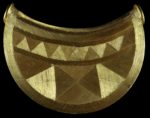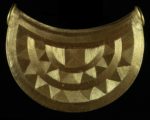 A gold bulla discovered by a metal detectorist in the Shropshire Marshes was one of the stars of the Portable Antiquities Annual Report unveiled at the British Museum on Tuesday. About 3,000 years old, it is the most south-westerly example of Bronze Age gold ever found in Britain and is one of only eight extant bullae found in Britain and Ireland. The only other bulla ever discovered in England was dredged from the Irwell ship canal in the 18th century, was sold for a couple of pounds and disappeared from the record. It is an exceptional piece.
A gold bulla discovered by a metal detectorist in the Shropshire Marshes was one of the stars of the Portable Antiquities Annual Report unveiled at the British Museum on Tuesday. About 3,000 years old, it is the most south-westerly example of Bronze Age gold ever found in Britain and is one of only eight extant bullae found in Britain and Ireland. The only other bulla ever discovered in England was dredged from the Irwell ship canal in the 18th century, was sold for a couple of pounds and disappeared from the record. It is an exceptional piece.
 This kind of jewelry is known as a bulla after the Latin word for bubble because it’s hollow inside. It is crescent-shaped with wedge-shaped sides and was created using at least two pieces of gold sheet. The top edge has collars on either side that were filled with clay or compacted soil, either deliberately or over the centuries it was buried. Between them is a tunnel which would have been used to thread a chain or necklace through to hang it as a pendant. The front and rear plates that make the body of the pendant are a single sheet of gold plate fixed at the mid-point of the top edge. A base plate closes the two sides of the plate. The fixing points are concealed so the plates and tube collar look like a single piece.
This kind of jewelry is known as a bulla after the Latin word for bubble because it’s hollow inside. It is crescent-shaped with wedge-shaped sides and was created using at least two pieces of gold sheet. The top edge has collars on either side that were filled with clay or compacted soil, either deliberately or over the centuries it was buried. Between them is a tunnel which would have been used to thread a chain or necklace through to hang it as a pendant. The front and rear plates that make the body of the pendant are a single sheet of gold plate fixed at the mid-point of the top edge. A base plate closes the two sides of the plate. The fixing points are concealed so the plates and tube collar look like a single piece.
 The components were probably soldered together as the use of solder is well-established in metal objects from this period in Britain. The composition of the bulla was tested with XRF-analysis, but the presence of solder — which in Bronze Age objects is higher in copper or silver than the rest of the piece — could not be conclusively identified.
The components were probably soldered together as the use of solder is well-established in metal objects from this period in Britain. The composition of the bulla was tested with XRF-analysis, but the presence of solder — which in Bronze Age objects is higher in copper or silver than the rest of the piece — could not be conclusively identified.
 The most striking element of the bulla is the decoration. Every surface is engraved with geometric designs filled with cut parallel lines and concentric curves. They are so precise, so even that the maker must have used a compass or divider to mark them out and then cut them using a graver with a 45 degree cutting edge. There are no punched or repousse patterns as have been found on other bullae. The deep grooves carved all over the piece suggest the gold sheet is comparatively thick and that the decoration was done on the completed pendant rather than on the sheets before they were put together.
The most striking element of the bulla is the decoration. Every surface is engraved with geometric designs filled with cut parallel lines and concentric curves. They are so precise, so even that the maker must have used a compass or divider to mark them out and then cut them using a graver with a 45 degree cutting edge. There are no punched or repousse patterns as have been found on other bullae. The deep grooves carved all over the piece suggest the gold sheet is comparatively thick and that the decoration was done on the completed pendant rather than on the sheets before they were put together.
To top it off, the lines go in alternating horizontal, vertical, semi-circular and diagonal directions, creating a dynamic graphic look as well as an incredible play of light that makes the gold reflect in different shades that underscore the intricate shapes. This is work of the highest quality, the greatest possible workmanship, material and design that is all but incomparable in a British context.

What an interesting piece!
The combination of overall shape and the geometric shapes brings to mind woven baskets and I wonder if earlier and less-precious predecessors of the design were indeed fiber artworks.
I have a cousin who used to assist on digs every summer. She was once asked to try on a gold torc (after it had been cleaned). They are quite heavy; she is not a sturdy woman. So well was it made that it felt light and entirely comfortable. She was pleased as punch and impressed no end.
Size? Weight?
Also, high purity gold is quite soft and I think that either the decoration had to be engraved prior to assembly or that the hollow piece had to be filled with something such as clay as a backing material prior to the engraving. It certainly would have been much easier to do the decoration on the edge piece flat and then bend it prior to soldering.
Answered my own question with the links, about 4 by 3 cm. Apparently, there are similar Irish examples filled with baked clay or lead.
You clearly see, where some ideas were coming from… 😉
————-
“…’Streamline Moderne’, sometimes termed ‘Art Moderne’, is a late type of the Art-Deco design style that emerged in the 1930s, emphasizing curving forms and long horizontal lines.”
————-
Also, one might wonder if there are a few more, and if they were worn together.
:hattip:
That is absolutely stunning. The striations look as though they might have been made with a comb-like tool.
Absolutely stunning, I can’t stop looking at it. Where might one see it?
If the marshes were there in ancient times, could this have been a sacrificed item? There does not seem to be any wear on the fine gold surface. Also, if the artist used an incised baked clay mold, he could have pressed the gold over the surface more easily. Historically, we assume geometry originated in the Middle East with the Arabs, but I don’t think this could be created without some knowledge of math or geometry. So intriguing~~thanks for posting!!